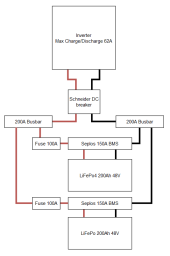Hi,
I am buidling 2x200ah batteries with Seplos BMS and will be connecting them to 5kW Hybrid inverter. The inverter can max charge/discharge at 62A. I already have Schneider DC breaker connected as it was used with Pylon batteries and intend to leave it there. The wires are 16mm2(6AWG). Since there will be 2 separate batteries I will use busbars and then 100A fuses. I am still not sure should I go wih ANL or NH00. I know recomended are class T fuses but the current is not going to be high.
Here are my questions:
Could I potentialy use DC breakers instead of fuses?
I am reading that the fuses should be close to battery. At the moment the fuse is before BMS. Should I move it between BMS and the battery?
Does attached diagram look ok?
Thanks

I am buidling 2x200ah batteries with Seplos BMS and will be connecting them to 5kW Hybrid inverter. The inverter can max charge/discharge at 62A. I already have Schneider DC breaker connected as it was used with Pylon batteries and intend to leave it there. The wires are 16mm2(6AWG). Since there will be 2 separate batteries I will use busbars and then 100A fuses. I am still not sure should I go wih ANL or NH00. I know recomended are class T fuses but the current is not going to be high.
Here are my questions:
Could I potentialy use DC breakers instead of fuses?
I am reading that the fuses should be close to battery. At the moment the fuse is before BMS. Should I move it between BMS and the battery?
Does attached diagram look ok?
Thanks



